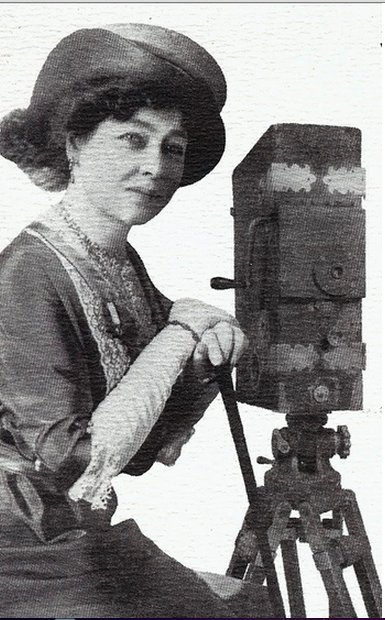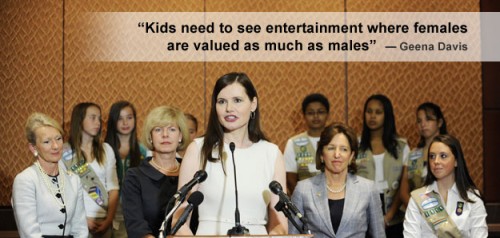This is a guest post by Kathleen Wallace.
Being a woman in and around the entertainment industry can feel like being in an unhealthy relationship: They’re just not that into us.
It wasn’t always this way. According to Dr. Jane Gaines, a film professor at Columbia University and one of the editors of the Women Film Pioneers Project, women in the film industry in America between 1916 and 1923 were more powerful than in any other business. In fact, in 1923, the number of women-owned production companies outnumbered those owned by men.


Fast forward 90 years to 2013, and only 23 percent of producers and a stunningly mere 7 percent of film directors are women (Geena Davis Institute on Gender In Media).

The statistics are startling, but the silver lining is promising: The conditions that brought women to the forefront in early film now exist in streaming media. Now is the time for marginalized communities to claim their most significant share yet of the media landscape by finding and funding streaming projects and investing in/forming streaming media companies.
When the moving image was uncharted territory, roles were less defined, which left greater room for minorities to take on more responsibility and to have more of a voice. According to Dr. Gaines, to meet the “booming demand” for fiction films between 1895 and 1925, “Women were given many, many more chances to direct and produce.”
The better part of a century later, streaming media outlets present an unprecedented demand for content. For example, in 2013, the average time spent on digital surpassed the time spent watching television. Soon mobile viewing will surpass digital viewing. Also unprecedented is the access content creators have to distribution via streaming media. And thanks to the advent of crowd-funding, the financial barrier to filmmaking is lowered and audiences have greater access to filmmakers and therefore greater say in what media is produced. What a time to be both a filmmaker and an audience member!

History teaches us, though, that this golden time will not last. In the 1920s and 1930s, as the film industry matured and companies figured out how to monetize films, underrepresented communities were squeezed out. Streaming is still, just as film was a century ago, the new frontier of media, but the “Streaming-TV Gold Rush,” as deemed by New York Magazine, is on: HBO announced recently that it will offer a streaming-only service. Lionsgate and Tribeca Enterprises (which runs the Tribeca Film Festival) announced the creation of a subscription VOD service. And it’s been over a year since Jason Kilar, ex-Hulu CEO, and Richard Tom, ex-Hulu CTO, announced the creation of their company, Vessel, a premium streaming platform specifically for short-form video content.
Deep pockets are searching for ways to make money in digital media. And the money is there to be found; earlier this year, digital ad revenues surpassed television ad revenue. The question is, when the big companies do find the money, what will happen to the level of diversity we enjoy in streaming media now?
This is not to say that studio executives are maliciously excluding underrepresented groups. Studio executives just aren’t that into us, so they don’t see as great a need to represent us. As Justin Simien, the director of the movie Dear White People (which incidentally was crowd-funded), said in a recent NPR interview, “It’s taken as given that a white cast represents everyone.” Organizations like the Geena Davis Institute on Gender in Media are drawing strong attention to the issue, but the statistics on equal representation are still depressing.
With streaming media, we don’t have to see ourselves through someone else’s lens anymore. And if we take the reins of streaming media now while the gold rush is on, we can help ensure that it stays that way.
Here are three steps to take those reins:
First, find streaming content that speaks to you. There is seemingly limitless content on the big platforms like YouTube and Vimeo. There are also smaller companies like Seed&Spark, which cater to independent filmmakers. This company definitely harkens back to the early days of film: Seed&Spark is a female-lead company helps filmmakers fundraise as well as distribute their films, and 58 percent of the projects crowd-funding in their studio have women in prominent positions. (Full disclosure: I am currently crowd-funding my own web series through Seed&Spark. It’s called Settling Up.)
Second, when you find a project you like, support it. Throw money behind it. It doesn’t have to be a lot; truly every bit helps. Then spread the word. A Facebook post or tweet to your followers helps raise the project’s profile. Large numbers of both donors and followers signal to the streaming studios to come – like Vessel – that there is an underrepresented audience out there craving more content tailored to them.
Supporting projects also helps you build a relationship with your favorite streaming filmmakers, which helps ensure their projects’ longevity, since funding for streaming is still largely grassroots-based. “Relationships have made the most successful web series what they are today,” says Amy Kersten, an independent streaming producer whose work centers on women and women’s issues. When you subscribe to a series, when you post about an indie VOD film, when you comment on a video, you are creating dialogue between yourself and the filmmaker which helps ensure content is of the people. (Again, full disclosure, Amy is producing and co-directing my web series.)
Third, make streaming media yourself or get involved in a streaming media company. If this last one is for you – and it may not be – I strongly urge you to go for it. Underserved communities need more representation behind the camera as well as behind the studio desk. My web series, Settling Up, is the first streaming media I’ve created, and I’ve learned tons along the way – made plenty of mistakes, too. But at the end of the day, I’m telling stories that have gone untold for too long, and I’m very proud that our female to male ratio on the crew ranges between 2:2 and 4:1.
It’s media for women, by women. And I’m definitely into that. Long may it last!
__________________________________________
Kathleen Wallace is a NYC-based writer-producer-actor. Her web series, Settling Up, premieres in early 2015. She works with Amios Theater Company and Barefoot Theater Company, teaches fitness and public speaking, and is founder and Chief Cape Advocate of Be A Superhero Day, a day of public service. Kathleen holds degrees from Yale and the National Theater Conservatory and certificates from multiple schools in Germany. This winter she appears as Amanda in Private Lives at the Walnut Street Theater in Philadelphia.











